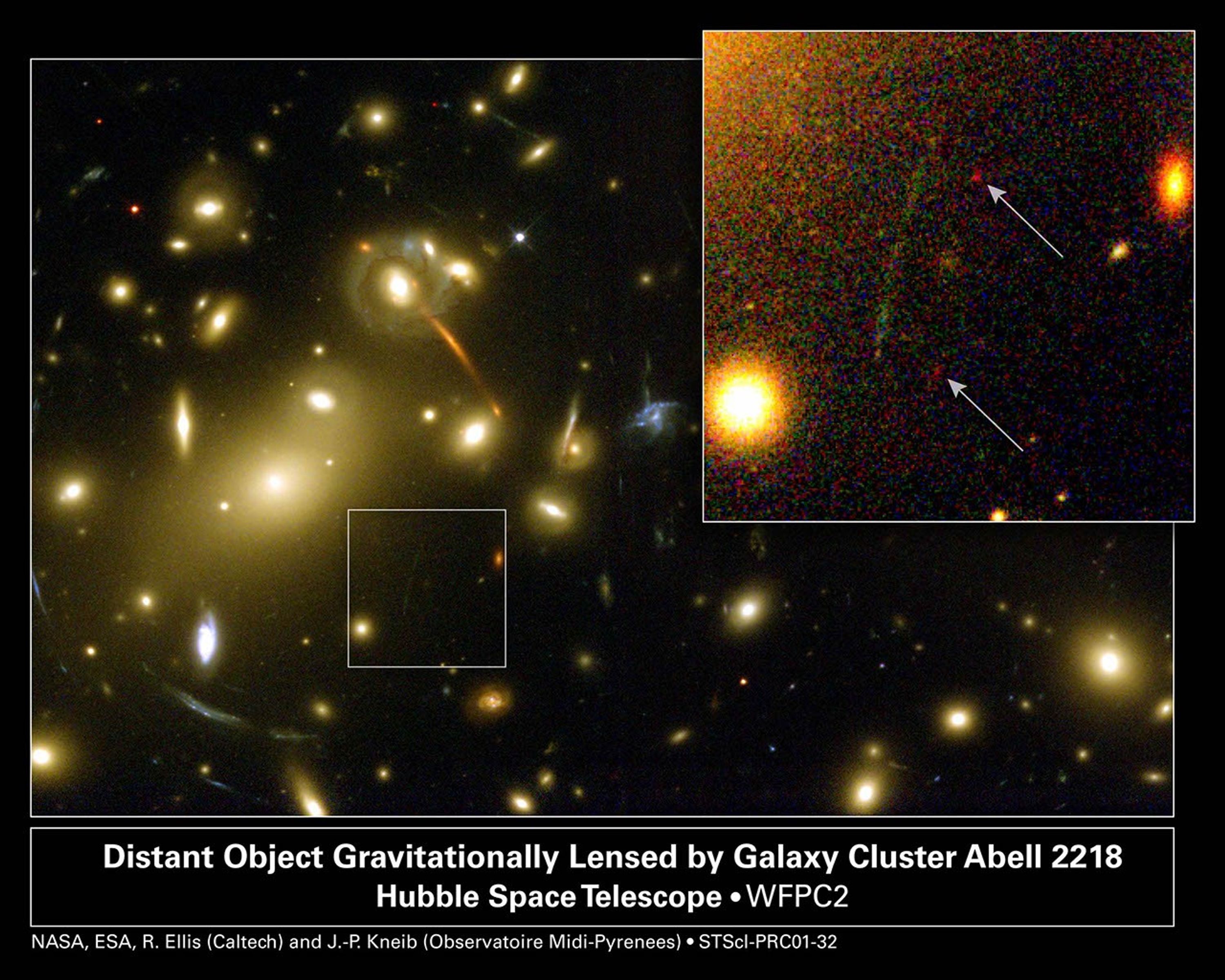1 min read
Gravitational Lens Helps Hubble and Keck Discover Galaxy Building Block

This NASA Hubble Space Telescope image shows a very small, faint galaxy 'building block' newly discovered by a unique collaboration between ground- and space-based telescopes. Hubble and the 10-meter Keck Telescopes in Hawaii joined forces, using a galaxy cluster which acts as gravitational lens to detect what scientists believe is one of the smallest very distant objects ever found.
The galaxy cluster Abell 2218 was used by a team of European and American astronomers led by Richard Ellis (Caltech) in their systematic search for intrinsically faint distant star-forming systems. Without help from Abell 2218's exceptional magnifying power to make objects appear about 30 times brighter, the galaxy building block would have been undetectable.
In the image to the right, the object is seen distorted into two nearly identical, very red 'images' by the gravitational lens. The image pair represents the magnified result of a single background object gravitationally lensed by Abell 2218 and viewed at a distance of 13.4 billion light-years. The intriguing object contains only one million stars, far fewer than a mature galaxy, and scientists believe it is very young. Such young star-forming systems of low mass at early cosmic times are likely to be the objects from which present-day galaxies have formed.
In the image to the left, the full overview of the galaxy cluster Abell 2218 is seen. This image was taken by Hubble in 1999 at the completion of Hubble Servicing Mission 3A.
About the Object
- R.A. PositionR.A. PositionRight ascension – analogous to longitude – is one component of an object's position.16h 35m 53.99s
- Dec. PositionDec. PositionDeclination – analogous to latitude – is one component of an object's position.66° 13' 0.0"
- ConstellationConstellationOne of 88 recognized regions of the celestial sphere in which the object appears.Draco
- DistanceDistanceThe physical distance from Earth to the astronomical object. Distances within our solar system are usually measured in Astronomical Units (AU). Distances between stars are usually measured in light-years. Interstellar distances can also be measured in parsecs.The lensing cluster of galaxies, (Abell 2218) is 600 million parsecs (2 billion light-years) away, along the same line of sight. The lensed galaxy is 4 billion parsecs (13 billion light-years) away.
About the Data
- Data DescriptionData DescriptionProposal: A description of the observations, their scientific justification, and the links to the data available in the science archive.
Science Team: The astronomers who planned the observations and analyzed the data. "PI" refers to the Principal Investigator.Principal Astronomers: J.-P. Kneib (Observatoire Midi-Pyrenees, France), R. Ellis and M. Santos (Caltech) and K. Kuijken (Kapteyn Institute, The Netherlands) - InstrumentInstrumentThe science instrument used to produce the data.Inset image: Keck I>Low Resolution Imaging Spectrograph, HST>WFPC2, and Keck II>Echelle Spectrograph and Imager
- Exposure DatesExposure DatesThe date(s) that the telescope made its observations and the total exposure time.Inset image: April 23, 2001, Exposure Time: 0.6 hours (Keck I), January 11 - 12, 2000, Exposure Time: 3.3 hours (HST), and May 21, 2001, Exposure Time: 1.1 hours
- FiltersFiltersThe camera filters that were used in the science observations.Inset image Low Resolution Imaging Spectrograph WFPC2: F814 W (I) Echelle Spectrograph and Imager Galaxy Cluster image F450W (Wide B), F606W (Wide V), and F814 W (I)
- Object NameObject NameA name or catalog number that astronomers use to identify an astronomical object.Abell 2218
- Object DescriptionObject DescriptionThe type of astronomical object.Gravitational Lensing Galaxy Cluster
- Release DateOctober 5, 2001
- Science ReleaseGravitational Lens Helps Hubble and Keck Discover Galaxy Building Block
- Credit

Share
Details
Claire Andreoli
NASA’s Goddard Space Flight Center
Greenbelt, Maryland
claire.andreoli@nasa.gov































